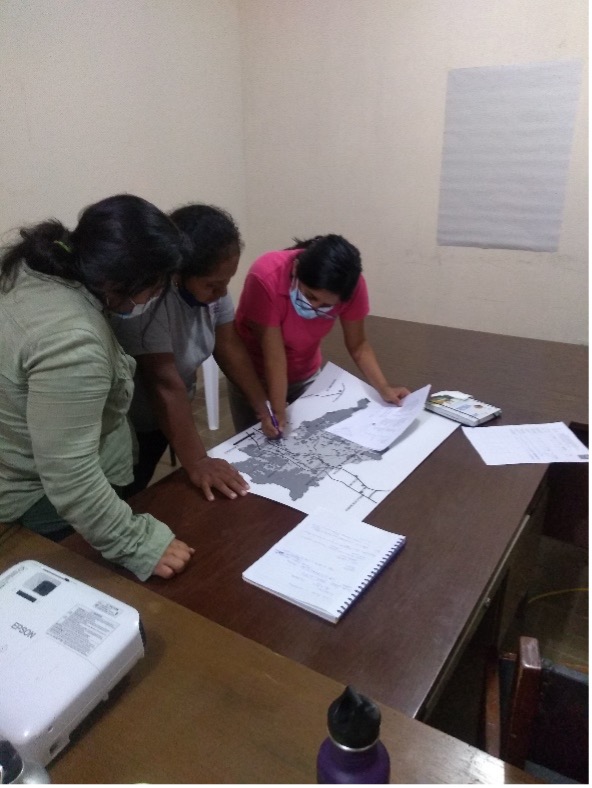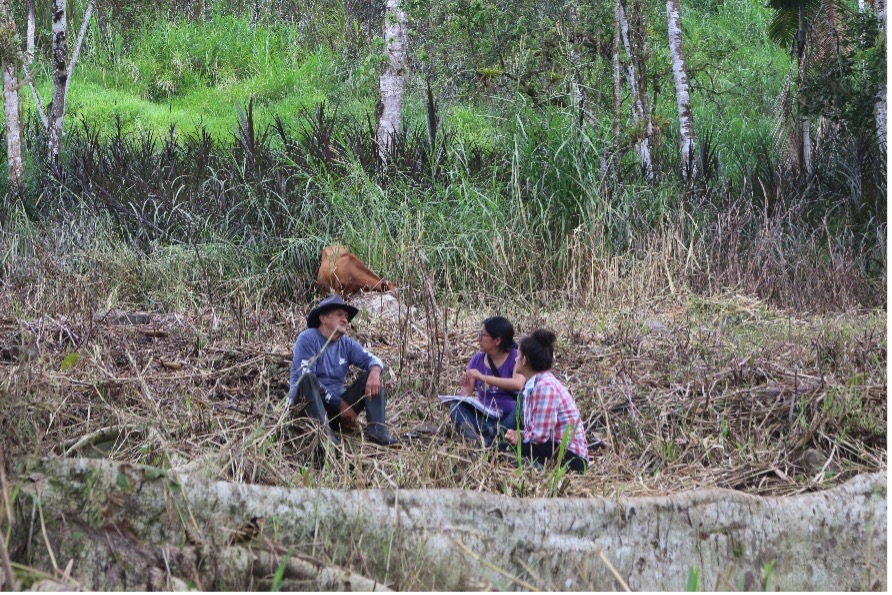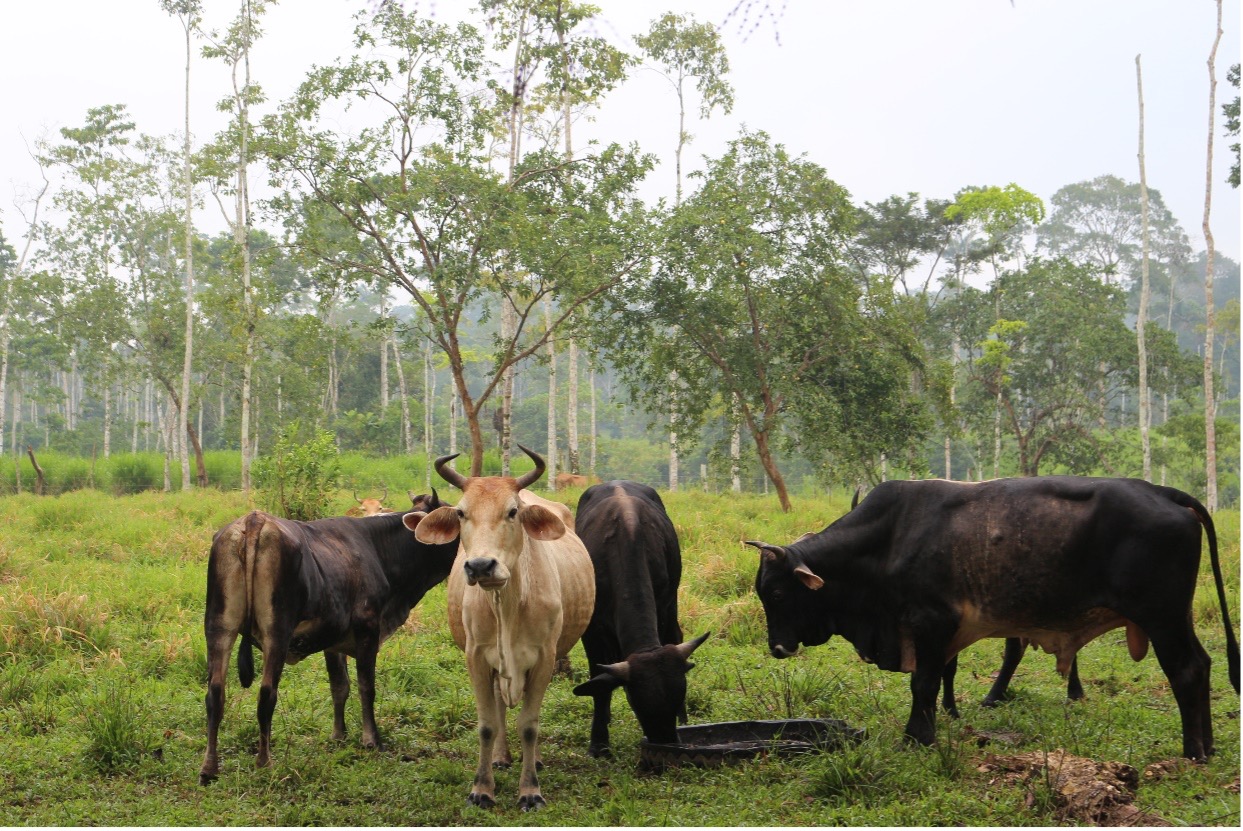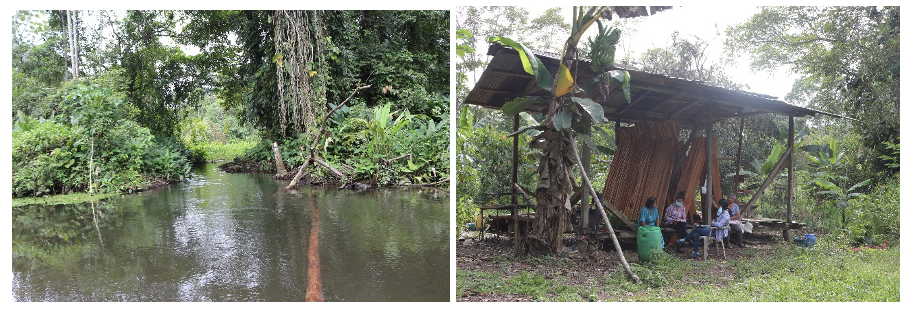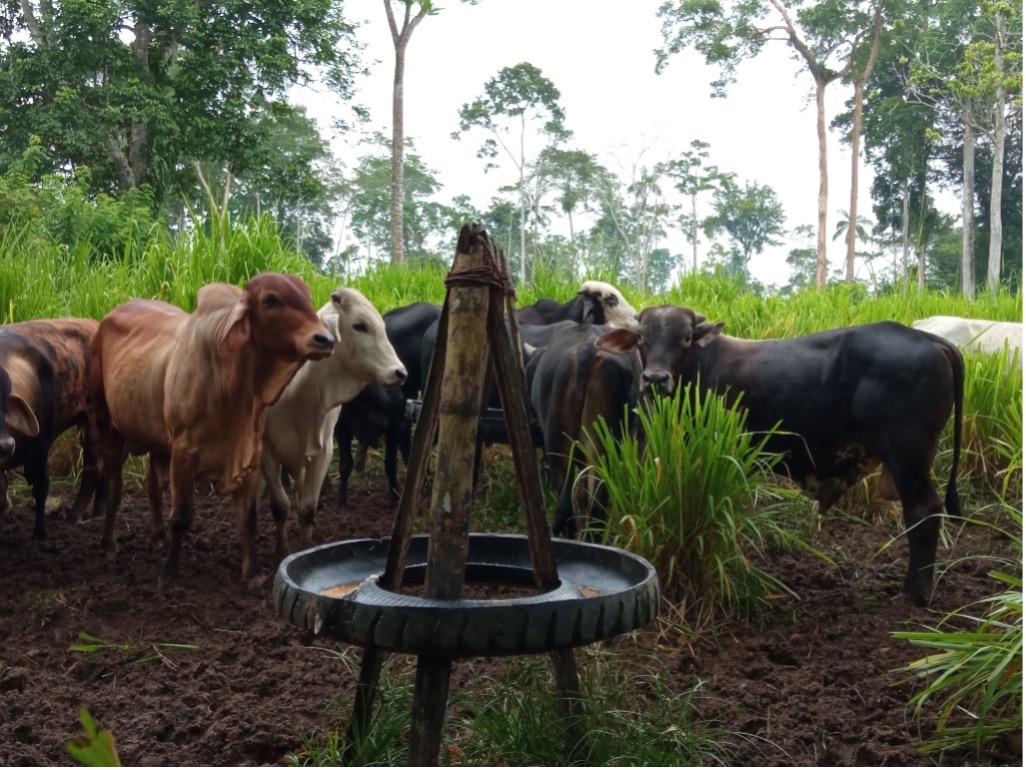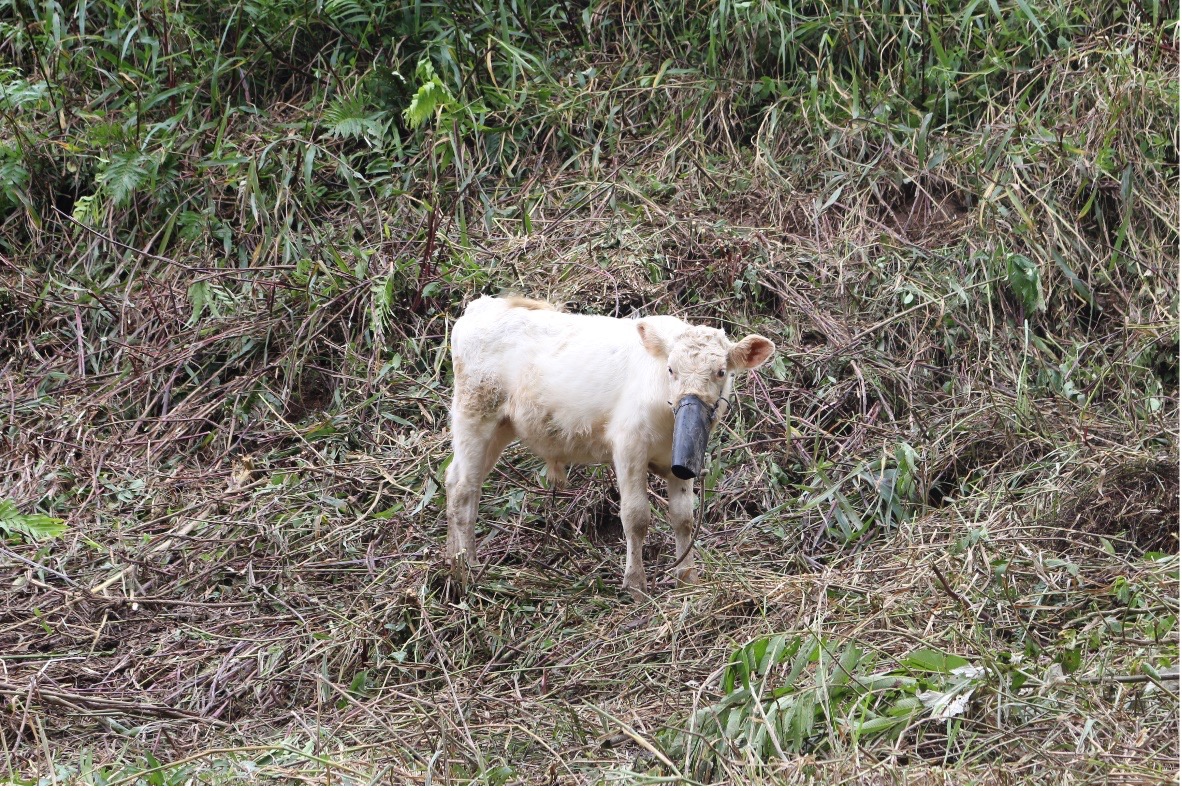The UNDP Ecuador Accelerator Lab, along with GIZ Ecuador, the GIZ Data Lab, and the University of Manchester, conducted a Data Powered Positive Deviance (DPPD) pilot in 2020-21 to learn about local, effective, and desirable cattle ranching practices in two cantons of the Ecuadorian Amazon: Joya de los Sachas and Sucúa. Our goal was to generate evidence of local solutions to inform the PROAmazonia program that aims to reduce CO2 emissions through the mitigation of deforestation and the promotion of sustainable land use.
We applied the DPPD method to identify positive deviants and understand their practices. The initial, quantitative research led us to identify potential positive deviants — cattle farms with consistently lower deforestation rates than what we were able to statistically predict for 2015 through 2020, using several variables that characterized the ranches.
The qualitative research that followed led us to refine our understanding of positive deviance in the context of cattle farming on the edge of the Amazon Forest, and to unpack some of the factors that enable said deviance.
In this post, we focus on the qualitative research phase, which builds on stakeholder mappings at the national, provincial, and local levels; a desk validation and a convenience sampling of the cattle farms identified in the quantitative research; the elaboration of a data collection instrument; and the collection of information through face-to-face interviews and field observations.
Desk validation and data cleaning
The quantitative research resulted in a list of 77 labelled cattle farms, ranging from “never positive deviants” to “always positive deviants”, depending on the evolution of their yearly rate of deforestation between 2015 and 2020. We individually reviewed these farms and added an “always positive deviants / strict” category for those whose overall deforestation rate was below 2% over the timeframe, so that we could use extreme case sampling in our qualitative research.
We then validated the list of farms with key informants from the Ministry of Agriculture and local governments who were familiar with the farm owners. This led us to identify and discard some farms that were not actually cattle farms. Although some livestock may have occupied the land, cattle were only temporarily present, and the farmers did not raise them.
These two steps helped us clean the data and prevented us from visiting and interviewing false positively deviant farmers.
Sample design and access to informants
We then conducted a convenience sampling to ensure the diversity of the farms we would visit, and farmers we would interview. Sample diversity was achieved in the farms pasture (%), forest (% and ha), poverty level (index), access to roads, and proximity to the main city, to improve the generalizability of the findings. We analyzed indicators such as: animal unit per hectare (which we referred to as cattle efficiency), percentage of land dedicated to pasture, percentage and area of forestland within a farm, and poverty index level. We also drew transects based on distances to main local cities and access to roads.
Meeting with local technicians of the Amazonian Agenda of the Productive Transformation (ATPA) from MAG Sucúa, with the aim of setting a field work schedule using the identification of farmers’ location in a territory. Photo: Emily Wilkinson
We selected 18 farms — 6 in Sucúa and 12 in Joya de los Sachas — from both the “always positive deviants / strict” and “non-positive deviant” groups. The inclusion of non-positive deviants would make it easier to identify uncommon practices and strategies among positive deviants by comparing them with normative and common behaviour. We included a greater number of positive deviants, since ultimately our objective was to unpack their sustainable practices. We then identified key informants through snowball sampling to understand who was involved in sustainable livestock farming at the national, provincial, and cantonal levels.
We interviewed six people: three from Pro Amazonía, one from FAO, one from the Agenda de Transformación Productiva Amazónica of the Ministry of Agriculture, one from the provincial government of Orellana, and one local leader from the province of Orellana. In addition to these individuals, we met with local institutional technicians who greatly facilitated our access to the 18 selected farms.
Interviews were initially conducted virtually, due to the COVID-19 pandemic, and eventually in person, during field visits. Interviews with national and provincial informants focused mainly on the implementation of sustainable practices, policies, and their contacts in the local headquarters of their institutions. Interviews with local, cantonal informants focused on context and sustainable practices implemented at a farm level. The information gathered was highly valuable as it provided insights into a broader pool of farms than the 18 farms we selected. It also guided us in the design of our data collection instrument.
Responsible data collection
We carried out our work at a very political moment in Ecuador. The country was in the midst of a presidential election, and we feared our interest in farmers’ practices would be associated with political motives. Indeed, political campaigning was at its peak, so we avoided asking participants to sign papers. Instead, we convened them to verbal socialization meetings to explain our work. We held one in Joya and one in Sucúa. We also used these meetings to plan field visits to farms with the farmers themselves. We were careful not to mention categories like “positive deviants” or “negative deviants” as we did not want people to feel pre-judged. However, we told them that we were interested in good, sustainable livestock farming practices.
Interviewing a cattle farmer in Sucúa Cantón, Morona Santiago province. Photo: Ricardo Araguillin
We believed cattle farmers would generally be aware of the environmental impact of their activities, and we did not want perceptions of judgement or fear of regulatory intervention to jeopardize their willingness to participate in our research. Therefore, we chose not to invite the local institutional officers who either worked for the provincial office or the Ministry of Agriculture and who had connected us with the farmers to participate in our field visits. We hoped this would reduce any feeling of supervision or inspection and would encourage more open and honest interactions. Finally, we asked participants for verbal consent to record their interviews.
Field interviews and findings
Overall, we interviewed 16 farmers. We asked them questions related to their socioeconomic status, income generating activities, livestock feeding and management techniques, soil use, environmental attitudes, and the training they had received. Our interview instrument combined closed questions with semi-structured ones that were intended to characterize farmers, identify attitudes and practices towards forest conservation, and to learn about knowledge sources and exchanges.
Livestock in paddocks in Cantón Joya de los Sachas. Photo: Ricardo Araguillin
From their responses and our field observations, we learned that forest conservation was rather driven by extrinsic factors than by intrinsic, positively deviant attitudes towards the forest or farming practices; and these extrinsic factors appeared in both farms that had been categorized as possible positive and non-positive deviants in our quantitative research.
We identified three main factors:
- Economic: some farmers simply lacked the resources to clear out forestland and invest in other crops.
- Topographic: ravines, swamps, and mountainous zones were not cleared out, because access was difficult and land use impractical.
- Demographic: older farmers could not physically engage in arduous tree-cutting activities and could not manage the resulting increase in need for supervision of their property.
Nevertheless, we did find some farmers who valued trees for reasons more intrinsic to their farming practices and broader economic activities, but irrespective of whether they had been categorized as possible positive or non-positive deviants in the quantitative data phase. For example, some would conserve endemic fruit trees on their land, because these could be a source of income. Others purposefully maintained a natural canopy for the shadow it provided. This helped reduce the strain on their cattle and contributed to their livestock’s wellbeing. The farmers could also compost the fallen leaves. Most farmers further saw the value of shade in protecting water sources. Trees would keep the ground moist in areas close to streams, which would increase the likelihood of a continuous source of water throughout the summer. Interestingly, three farmers, one of them belonging to an indigenous community, mentioned the value of the forest for its provision of traditional medicine and plants. Meanwhile, at the other end of the spectrum, others perceived the forest as a resource for wood and other goods that might be sold to generate revenue.
Preservation of water source and wood trees in farms as ecological and economic value. Photo: Ricardo Araguillin
Surprisingly, more than half of the farmers we interviewed either believed their farming practices had no environmental impact or they did not know whether they did.
"The truth is I cannot say if there is an impact, because I don’t know” - Farmer’s Testimony, Sucua
Only one third of the farmers perceived a negative impact, which they justified by a need to generate income for their households.
"Cutting down the forests would be detrimental to the environment, but we must do something to survive. We are not going to starve to death just to improve something. We act responsibly, we don´t just cut down trees for the sake of it.” - Producer Testimony, Joya Sachas
We were also able to identify several innovative practices that farmers had implemented to improve their productivity. These included reducing the size of paddocks with live fences within a pasture rotation system, planting shrubs along paddock boundaries, using food mixes, and building diverse types of feeders. These practices and techniques were either the result of individual experimentation, recommendations from neighbors, or borrowed from other farms.
A feeder made with a recycled tire to prevent wasting minerals and salt that otherwise would have been scattered throughout the field for cattle to consume while grazing. Photo: Ricardo Araguillin
The challenges we experienced
The administrative data we had access to was outdated as the land registers dated back to 2005-2006. This had two implications. On the one hand, some selected farms were difficult to locate; the farmers had either died, or the land had changed owners. On the other hand, the information related to farm size and cultivated area reported by the farmers themselves did not match that of the registration data; farmers often used unreported land obtained through inheritance, renting, or expansion. This meant their farms had a lower cattle efficiency (animal unit per hectare) than what was estimated in the quantitative research. Such indicators related to land use and stocking rate were mainly used to identify the positive deviants, hence, they count as our main source of error in the quantitative analysis that preceded the fieldwork research. This led to the identification of farmers who are false positive deviants. This also could explain why sustainable practices were not identified exclusively in the “Always positive deviants” category. However, the vaccination data used to estimate the cattle numbers turned out to be a useful proxy due to their large alignment with the numbers in the field. This encourages its use as a reliable estimate of cattle density in future applications.
If we were to run the project again, we would surely approach the local institutional technicians much earlier, ideally during our quantitative research. These actors know the farmers and the characteristics of the areas in which they live and work, which facilitates the validation of certain key assumptions, and ensures the complex dynamics of cattle farming and agriculture in the Amazon are not lost in data.
Another challenge we faced is related to the nature of the problem. Deforestation is a typical example of the “Tragedy of the Commons” i.e. situations were individuals with access to a common or shared resource act in their own interest and, contrary to the common good of other individuals in their community. Adaptive solutions to such problems might exist if a number of conditions are met. A few conditions could be to ensure that resources have confined boundaries, can be preserved, and are scarce. The latter would warrant that the users will have strong incentives to manage their resources in a sustainable fashion. Another important criterion is to investigate the presence of communities with a thick social network and social norms that promote conservation. Additionally, there should be resource economic dependence which would guarantee that failures by resource appropriators cannot be attributed to economic indifference. While most of those conditions were met, we encountered the existence of a thick social network that promotes conservation with only one farmer who belongs to an indigenous community (Kichwa). This community promotes tree conservation due to their medicinal benefits and the ancestral medicinal knowledge shared amongst community members.
Placing a cut gumboot around a calf’s mouth to prevent it from drinking its mothers’ milk so that the farmer can collect it. Photo: Aymé Muzo
Recommendations
We recommend strengthening training programs on sustainable economic activities, as we learned that some farmers are likely to engage in monocultures (palm, cocoa, coffee, balsa) when market prices are high, without anticipating future market fluctuations. We believe more diversified economic activities are likely to be safer for longer-term household income and soil quality. When farmers were asked about where or how they learned their cattle farming practices—feeding and optimizing resources—most responded some form of empirical learning from previous generations or neighbors. They also stated that they had either not received any specific training in the past, or that their latest training on livestock production was over eight years old. This led some farmers to declare little confidence in their practices.
Reforestation initiatives are also likely to be unsuccessful if farmers are not provided with the necessary resources or materials for fencing. Indeed, new trees tend to have a high mortality rate, especially if they are exposed to cattle. Among those we interviewed, only a few middle-income farmers were able to keep newly planted trees alive, because they were able to invest in fencing. We generally encourage programs to investigate mid- to long-term risks to ensure sustainability.
We believe ProAmazonía’s “Field Schools” present an excellent opportunity to act on these recommendations and improve local farmers’ capacities, as they are based on site experiential learning where expertise is local and diverse. The farms where we identified the frugal innovations and the sustainable cattle farming practices can act as such learning sites, where famers can access and learn about those positively deviant practices and strategies.
Every farmer’s decision to deforest is motivated by many factors, but they all boil down to an economic want. However, when negative externalities outweigh the social benefit (i.e. the marginal private cost is below the marginal social cost) then deforestation should be restricted. And the goal here should be to reach a point where the marginal social benefit of deforestation will be above or at least equal to the marginal private benefit. If government efforts characterized in direct regulation, command-and-control policies and voluntary solutions has failed to reach this point, there is the need to return greater percentage of forest management and conservation to the people and have better-tailored incentive policies. By shifting towards community-based forest management, the responsibility of guarding and controlling the forest areas is left in the hands of the local people with little or no intervention by the government. And in this pilot project, we attempted to present the opportunities and challenges of sourcing community-based solutions for forest conservation.
---
About the Data Powered Positive Deviance initiative
The Data Powered Positive Deviance initiative was established on the belief that lessons on how to tackle complex sustainable development challenges are best learned from the people who face those challenges every day. It is with this mindset that the GIZ Data Lab, the University of Manchester Centre for Digital Development, and the United Nations Development Programme Accelerator Labs are conducting a series of pilots in different countries and domains to uncover effective, locally developed practices and innovations as a response to development challenges.
Contact:
- UNDP Ecuador Accelerator Lab: Paulina Jiménez paulina.jimenez@undp.org Ana M. Grijalva: ana.grijalva@undp.org
- GIZ Data Lab: Catherine Vogel: datalab@giz.de
- University of Manchester: Basma Albanna: basma.albanna@manchester.ac.uk
- UNDP Accelerator Labs: Jeremy Boy: jeremy.boy@undp.org

 Locations
Locations